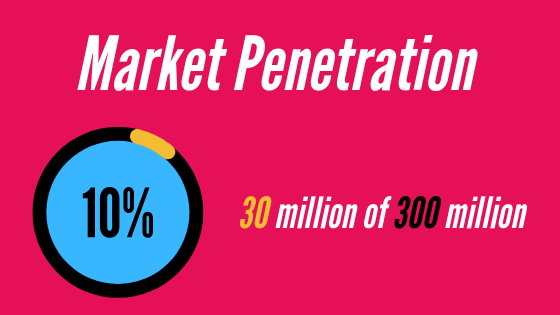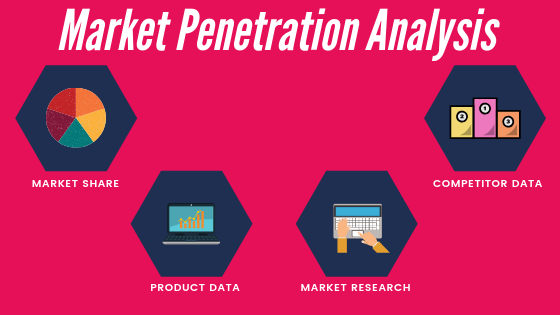Everything You Need To Know About Market Penetration
Market penetration is a set of activities pursued by companies to increase the market share of a product
Market penetration is the art and science of increasing sales of existing products/solutions/services without changing them. Usually, it is applied to merchandise that is selling in a specific geography.
"For tomorrow belongs to the people who prepare for it today."
It doesn't matter what line of business you are in - whether you run a large technology firm or you are a solopreneuer, you need a game plan. Your game plan must be tailor-made to your objectives, industry, and opportunities. An integral aspect of the aforementioned strategic plan is a marketing plan.
A marketing plan serves as a guide towards the ultimate marketing objective(s) of a company. Considering the numerous elements of a marketing plan, in this article, we deal with a specific one from the mix, i.e., Market Penetration.
"Market penetration is a low pricing strategy adopted by companies for new and existing products to attract a larger number of buyers and a larger market share" - (Kotler and Armstrong, 2009)
Market penetration can be one of two things depending on the context.
- It is a metric.
- It is an activity.
Market Penetration as a Metric:
It is the measure of product adoption versus the theoretical market for the product. Let's understand this better with an example:
A wristwatch is a ubiquitous article of daily use. The potential market for it is significant. Let us assume the target audience size is 300 million.

Let us further assume that among the 300 million potential users, 30 million wear wristwatches.

The formula for market penetration is the number of people who wear a watch (30 million) versus the total target group (300 million). When expressed in the form of a percentage, wristwatches have a market penetration of 10%.

Market Penetration as an Activity:
Market penetration is a set of activities pursued by companies and businesses that increase the market share* of a specific product or service.
*Market share is defined as the amount of business a specific company controls in a market.
Let us now understand the difference between market share and market penetration.
Market Penetration vs. Market Share
In the previous example, let us assume there exists a premium brand of wristwatches called Xelor. Now, if there are 7.5 million Xelor owners out of the 30 million wristwatch users, then the market share of Xelor is 25%. ( Damn!)

Although used interchangeably, market penetration and market share are different yet closely related.
Now, here's the real kicker: market penetration or activities pursued to increase market penetration improve the market share of a product.
If Xelor were to run a marketing campaign aimed at a target audience who do not wear wristwatches and can get 2.5 million new customers, then:
1. Xelor has increased market penetration from 10% to 10.8% (2.5 million new users/300 million target group is 0.8%) .
2. 32.5 million watch users in the total market of 300 million. (10.8%).
3. Xelor has also expanded its market share from 25% to 30.7% (10 million Xelor users/32.5 million users is 30.7%).
In contrast, if Xelor's competitors were to do the same and increase market penetration and its market share, Xelor would see a drop in its market share.
Market Penetration Strategies
Let us now look at popular market penetration strategies that companies leverage.
Lowering Price
A tried-and-tested method of increasing market penetration is to lower the price of an existing product line. Companies reduce the sale price to make it attractive and make it affordable for more customers, who couldn’t purchase it earlier.
Discounts
Some companies prefer using the discount word and often make it compelling with emotional hooks that persuade customers to purchase it. Words such as ‘Hurry, stocks disappearing fast,’ ‘offer valid until stocks last,’ and ‘offer valid until Dec 31 only’ are examples of emotional hooks.
Aggressive Advertising
Companies use aggressive advertising as a market penetration strategy to reach a broader target audience. Television, print media, billboards, hoardings, banners, street corners, etc. are different modes of aggressive advertising.
Increasing Usage
This market penetration is used to increase the usage of a product within the customer base. For example, a SaaS product may have 50 users within an enterprise customer’s company. The SaaS company can onboard more users as existing users begin experiencing its benefits. This strategy increases revenues from a single existing customer.
Simplifying the buyer’s journey
As more products and services enter a market, it is increasingly difficult to get a buyer’s attention. One way of doing it is by simplifying the buyer’s journey, i.e., by making it intuitive for customers to use a product. Stripping a product of its complexities and making it irresistible to use is a useful market penetration strategy.
Adding New Features
Another impactful market penetration strategy is to add more features to an existing product without turning it upside down. For example, a CRM product could have an email integration feature added to it so that it appeals to users who were shying away from it earlier. Remember, when mobile phones were added with GPS features to increase their applicability and uses? That set in motion a new era of apps that used GPS services to solve unique customer challenges.
Innovative Marketing
Marketers often use innovative marketing techniques to boost market penetration for products and services. Audi encourages users to select alternate choices on life-sized screens to experience how it looks.
Retailers have long been using virtual reality to enable customers ‘virtually’ try apparel and experience it before purchasing them. Similarly, marketers use innovative techniques such as 360-degree videos, chatbots, and user-generated content to innovatively increase market penetration.
Dealerships & Partnerships
Another example of a market penetration strategy is signing up newer partnerships to reach a broader target audience. Partners and dealers have an extensive geographical presence and can appeal to newer users for an existing product. An ideal example is how consumer electronics manufacturers rely on retailers and distributors to sell their products.
Resellers
Resellers purchase products from manufacturers at a discounted rate and sell them at a higher price to make money out of the transaction. They even provide post-purchase support (such as product demos and onboarding) to ensure higher customer retention. While they may have a target customer base, they also strive to bring in new customers within their fold.
Enter Newer Geographies
Entering unexplored markets is a proven market penetration technique to increase the uptake of a product. Companies who have been successful in one geography can launch their product in different geographies as the use case tends to be similar.
Influencer Marketing
Companies prefer partnering with influencers to spread the word around about their products. Famous personalities having massive followers on social media platforms (Instagram, Facebook, Twitter, and LinkedIn) can influence the sales of a product.
Integrated Marketing
Integrated marketing helps deliver a unified and consistent experience for customers to interact with a brand or company. In a complex and fragmented world of marketing, integrated marketing enables combining all individual marketing efforts.
For example, a product can be marketed across different media (YouTube, television ads, mobile ads, etc.) to convey the same message across all channels.
Field Marketing
Field Marketing is carried out by highly trained marketers that contribute to the brand building, customer relationship management, lead generation efforts of a client/company.
It includes targeted direct sales promotions, merchandising, auditing, sampling, demonstration, experiential marketing, organizing roadshows, and events. Field marketers can help users get acclimatized to a product quickly and enable higher market penetration.
Thwart Competition
Companies often improve market penetration by building features that their competitors will find it hard to replicate. Or, by creating efficient processes that result in cost savings that other competitors cannot match. Building a trustworthy customer relationship is a good way of keeping the competition at bay and increasing market penetration.
Advantages and Disadvantages of Market Penetration
Like every marketing strategy, market penetration has certain advantages and disadvantages that marketers need to be aware of.
Advantages of Market Penetration
Market penetration has a few distinct advantages for companies to put it to use:
Increases Sales
Undoubtedly, its primary objective is to increase sales. Market penetration strategies, when applied correctly, can contribute positively to the top line of a company.
Improve Product Visibility
Unique market penetration strategies can increase the visibility of a product/service in unexplored geographies and market segments. However, a company should only
enter buyer segments in which it can create superior customer value and gain advantages over its competitors.
Enhances Brand Equity
Market penetration can enhance the brand equity of a company. For example, a watch brand such as Rolex can use market penetration strategies to leverage its already distinguished public perception of accuracy, exclusivity, and robustness.
Improve Product Positioning
A company can offer higher customer value by either charging lower prices than competitors or providing more
benefits to justify higher sale prices. Thus, effective positioning begins with differentiation - actually differentiating the company’s market offering to create superior customer value. Companies must take steps to deliver and communicate the differentiation that supports the chosen positioning strategy.
Disadvantages of Market Penetration
Here are a few disadvantages that market penetration strategies have:
Faltering Brand Image
When companies reduce the price of a product, they risk diminishing the image of the product/brand in the minds of customers and creating the wrong perception. Some customers may feel the company has no option but to reduce the price or offer it at a discount due to its dwindling popularity.
Attract the ‘Wrong’ Audience
When newer members of the target audience come in contact with a product due to its market penetration strategy, not all of them will be ideal customers. There is the risk of a wrong ‘product fit’ that could hinder the image of the company. It happens due to incorrect market segmentation.
Creates Undue Pressure
Market penetration can create unwanted pressure on other departments, such as manufacturing, production, and sales. Manufacturers may not be able to lower their costs as quickly as expected, and producers may not be able to drive efficiencies in their processes. Sales reps may not be able to push products and services out as they would have liked.
Product Market Matrix
An analysis of market penetration is incomplete without examining market penetration as a part of Igor Ansoff's product-market matrix.
The best way to understand this matrix would be to apply it to real business and see how the model has translated into profitable growth for the latter.
Let us apply it to the sports apparel behemoth, Under Armour. Under Armour, founded in 1996, is an American company that makes footwear, sports, and casual apparel.

Under Armour's Market Penetration Strategy
It involves improving the sales of the current product lines by optimizing the marketing mix. Under Armour realized this using a two-pronged approach:
1. Under Armour boosted spending on endorsements and advertisement by 35%.
One of their most successful endorsement deals included signing the rising BasketBall star, Stephen Curry, which contributed to a significant boost in revenue from footwear.

2. It enhanced the different channels of sale like stores, e-commerce.
With the decline of brick-and-mortar stores, Under Armour intended to reduce its dependence on the latter. As a result, direct-to-consumer sales went up three times.
Under Armour's Market Development Strategy
Under Armour's market development strategy was to look out for and capitalizing markets and demographics for existing products.
Under Armour executed this strategy by increasing its promotion of their products to the women consumers via stellar ad campaigns like the 'I will what I want' campaign.
This campaign spurred sales in the Woman’s apparel division, and the sales numbers are set to reach $1.8 billion.
Under Armour's Product Development Strategy
New products are introduced to existing customers and demographics to engage in product development.
In between the years, 2006-2009, Under Armour achieved the below significant milestones to boost sales by 44%:
- Signed a 6-year $60 million deal with the NFL (National Football League)
- Released a new line of running shoes.
Under Armour's Diversification Strategy
Diversification is a high-risk maneuver of entering new markets with new products that are outside the company’s current product mix.
Under Armour exhibits this strategy by acquiring businesses in digital fitness tracking space like MyFitnessPal and MapMyFitness. It also collaborated with IBM to incorporate AI into fitness and sleep tracking.
Market Penetration Analysis
Before diving into formulating and executing market penetration strategies, it is vital to understand the company's current position in the market in terms of factors like product adoption, demographics. In case the company is a new entrant, it helps to learn the current state of the market and the big players in it.
The insights we need to seek while performing a market penetration analysis:

Market Share
In the long run, increasing market share translates into profits. Hence understanding the current market position and working upwards is necessary.
Competitor Data
Currently, in the market, it is crucial to have the edge over your competition a.k.a a competitive advantage. Data gained from competitive intelligence should be used to understand the competitor's strategy, its products, prices, channels, and promotions.
Product Data
Analyze every product/service provided to map its strength and weaknesses. Looking into aspects such as the attractiveness of the product's market and the product's strength in its market will allow you to determine and choose which opportunities to pursue.
Market Research
The first step of every marketing process is to engage in market research. It aids in understanding the complexity with which the market operates and also the needs and wants of customers.
Areas of Research:
- Demographics
- The Economic Environment
- The Technological Environment
- The Political - Social and Cultural Environment
Market Penetration Technology
Technology has dramatically influenced how businesses and companies enter and thrive in a market. Resisting this change can be a severe disadvantage.
The advent of the internet has changed the market landscape. The era of large monopolies ruling the market is waning. The internet has handed a plethora of tools into the hands of every commoner that would allow them to influence and sell to millions of people.
Data
Companies sit on troves of data on customers that they leverage to create profiles of likely customers and use targeted marketing channels to reach those people.
Social Media
The adoption rates of social media are insane! Over 2.77 billion people are estimated to be on social media by 2019. Businesses have used innovative social media campaigns to reach their target audience and promote their product.
For example, a campaign by Coca-Cola called the 'Share a Coke' was launched in Australia to target 23 million potential customers. Since its launch in 2011, there was a 7% increase in consumption by the target audience, over 250 millions of bottles sold.
So it can be concluded that technology, especially the internet, has dramatically impacted market penetration as an activity.
Market Penetration Pricing
Penetration pricing is the process of setting a low price initially to increase the product/service adoption rate. It helps the company get a quick boost in market share and attract a large number of customers.
Although there are certain aspects to consider while using this strategy:
- The market must be price sensitive.
- An increase in sales should drive down production and distribution costs.
- Must have the financial clout to sustain the low-pricing strategy.
Market Penetration Pricing Case Study:
Wavestorm was a new entrant in the surfboard market. Before their foray into this market, entry-level surfboards cost $300 to $1000. Wavestorm upended the market by introducing a surfboard at $99.99. This market penetration strategy allowed them to capture a significant market share and propelled them to the position of the market leader. The company sold almost five times the number of boards compared to any other competitor.
